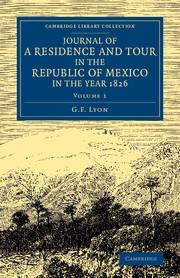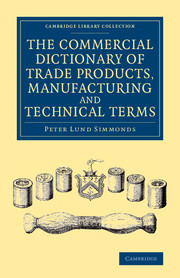Refine search
Actions for selected content:
26946 results in Economic history

Journal of a Residence and Tour in the Republic of Mexico in the Year 1826
- With Some Account of the Mines of that Country
-
- Published online:
- 18 December 2014
- Print publication:
- 17 July 2014
- First published in:
- 1828

The Commercial Dictionary of Trade Products, Manufacturing and Technical Terms
- With a Definition of the Moneys, Weights, and Measures, of All Countries, Reduced to the British Standard
-
- Published online:
- 18 December 2014
- Print publication:
- 21 August 2014
3 - Discord
-
- Book:
- The Merchant Republics
- Published online:
- 05 December 2014
- Print publication:
- 11 December 2014, pp 115-171
-
- Chapter
- Export citation
Copyright page
-
- Book:
- The Merchant Republics
- Published online:
- 05 December 2014
- Print publication:
- 11 December 2014, pp iv-iv
-
- Chapter
- Export citation
Abbreviations
-
- Book:
- The Merchant Republics
- Published online:
- 05 December 2014
- Print publication:
- 11 December 2014, pp xii-xvi
-
- Chapter
- Export citation
Frontispiece
-
- Book:
- The Merchant Republics
- Published online:
- 05 December 2014
- Print publication:
- 11 December 2014, pp ii-ii
-
- Chapter
- Export citation
5 - Virtuous commerce
-
- Book:
- The Merchant Republics
- Published online:
- 05 December 2014
- Print publication:
- 11 December 2014, pp 214-265
-
- Chapter
- Export citation
Introduction
-
- Book:
- The Merchant Republics
- Published online:
- 05 December 2014
- Print publication:
- 11 December 2014, pp 1-17
-
- Chapter
- Export citation
2 - Political dynamics and dilemmas
-
- Book:
- The Merchant Republics
- Published online:
- 05 December 2014
- Print publication:
- 11 December 2014, pp 74-114
-
- Chapter
- Export citation
Bibliography
-
- Book:
- The Merchant Republics
- Published online:
- 05 December 2014
- Print publication:
- 11 December 2014, pp 319-346
-
- Chapter
- Export citation
4 - Merchants and republicans
-
- Book:
- The Merchant Republics
- Published online:
- 05 December 2014
- Print publication:
- 11 December 2014, pp 172-213
-
- Chapter
- Export citation
1 - A topographical perspective
-
- Book:
- The Merchant Republics
- Published online:
- 05 December 2014
- Print publication:
- 11 December 2014, pp 18-73
-
- Chapter
- Export citation
6 - Virtue bankrupt
-
- Book:
- The Merchant Republics
- Published online:
- 05 December 2014
- Print publication:
- 11 December 2014, pp 266-309
-
- Chapter
- Export citation
The Merchant Republics - Title page
-
-
- Book:
- The Merchant Republics
- Published online:
- 05 December 2014
- Print publication:
- 11 December 2014, pp iii-iii
-
- Chapter
- Export citation
Dedication
-
- Book:
- The Merchant Republics
- Published online:
- 05 December 2014
- Print publication:
- 11 December 2014, pp v-vi
-
- Chapter
- Export citation
Acknowledgments
-
- Book:
- The Merchant Republics
- Published online:
- 05 December 2014
- Print publication:
- 11 December 2014, pp viii-x
-
- Chapter
- Export citation
The Merchant Republics - Half title page
-
- Book:
- The Merchant Republics
- Published online:
- 05 December 2014
- Print publication:
- 11 December 2014, pp i-i
-
- Chapter
- Export citation
Contents
-
- Book:
- The Merchant Republics
- Published online:
- 05 December 2014
- Print publication:
- 11 December 2014, pp vii-vii
-
- Chapter
- Export citation
Index
-
- Book:
- The Merchant Republics
- Published online:
- 05 December 2014
- Print publication:
- 11 December 2014, pp 347-356
-
- Chapter
- Export citation
Conclusion
-
- Book:
- The Merchant Republics
- Published online:
- 05 December 2014
- Print publication:
- 11 December 2014, pp 310-318
-
- Chapter
- Export citation
